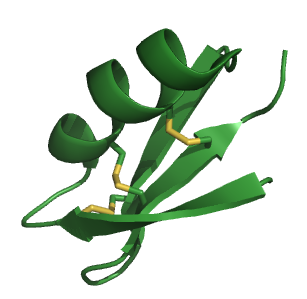Related Research Articles
Growth hormone–releasing hormone (GHRH), also known as somatocrinin or by several other names in its endogenous forms and as somatorelin (INN) in its pharmaceutical form, is a releasing hormone of growth hormone (GH). It is a 44-amino acid peptide hormone produced in the arcuate nucleus of the hypothalamus.

Vasotocin is an oligopeptide homologous to oxytocin and vasopressin found in all non-mammalian vertebrates and possibly in mammals during the fetal stage of development. Arginine vasotocin (AVT), a hormone produced by neurosecretory cells within the posterior pituitary gland (neurohypophysis) of the brain, is a major endocrine regulator of water balance and osmotic homoeostasis and is involved in social and sexual behavior in non-mammalian vertebrates. In mammals, it appears to have biological properties similar to those of oxytocin and vasopressin. It has been found to have effects on the regulation of REM sleep. Evidence for the existence of endogenous vasotocin in mammals is limited and no mammalian gene encoding vasotocin has been confirmed.
omega-Grammotoxin SIA (ω-grammotoxin SIA) is a protein toxin that inhibits P, Q, and N voltage-gated calcium channels (Ca2+ channels) in neurons.

Agitoxin is a toxin found in the venom of the scorpion Leiurus quinquestriatus hebraeus. Other toxins found in this species include charybdotoxin (CTX). CTX is a close homologue of Agitoxin.

Grammotoxin is a toxin in the venom of the tarantula Grammostola spatulata. It is a protein toxin that inhibits P-, Q- and N-type voltage-gated calcium channels in neurons. Grammotoxin is also known as omega-grammotoxin SIA.

Neurophysin II is a carrier protein with a size of 19,687.3 Da and is made up of a dimer of two virtually identical chains of amino acids. Neurophysin II is a cleavage product of the AVP gene. It is a neurohypophysial hormone that is transported in vesicles with vasopressin, the other cleavage product, along axons, from magnocellular neurons of the hypothalamus to the posterior lobe of the pituitary. Although it is stored in neurosecretory granules with vasopressin and released with vasopressin into the bloodstream, its biological action is unclear. Neurophysin II is also known as a stimulator of prolactin secretion.
Tazarotene-induced gene-1 (TIG1) is a protein which has been implicated as a putative tumor suppressor. It is structurally similar to the protein latexin, which has also been shown to demonstrate some tumor suppression activity. TIG1 is thought to be a transmembrane protein, and its mechanism of tumor suppression is largely unknown.
Orexin-A, also known as hypocretin-1, is a naturally occurring neuropeptide and orexin isoform. The orexinergic nucleus in the lateral hypothalamus is the primary orexin projection system in the brain.
Taspoglutide is a pharmaceutical drug, a glucagon-like peptide-1 agonist, under investigation for treatment of type 2 diabetes being codeveloped by Ipsen and Roche.
Leumorphin, also known as dynorphin B1–29, is a naturally occurring endogenous opioid peptide. Derived as a proteolytic cleavage product of residues 226-254 of prodynorphin, leumorphin is a nonacosapeptide and has the sequence Tyr-Gly-Gly-Phe-Leu-Arg-Arg-Gln-Phe-Lys-Val-Val-Thr-Arg-Ser-Gln-Glu-Asp-Pro-Asn-Ala-Tyr-Ser-Gly-Glu-Leu-Phe-Asp-Ala. It can be further reduced to dynorphin B and dynorphin B-14 by pitrilysin metallopeptidase 1, an enzyme of the endopeptidase family. Leumorphin behaves as a potent and selective κ-opioid receptor agonist, similarly to other endogenous opioid peptide derivatives of prodynorphin.
Modified GRF (1-29) often abbreviated as mod GRF (1-29), originally known as tetrasubstitued GRF (1-29), is a term used to identify a 29 amino acid peptide analogue of growth-hormone-releasing hormone (GHRH), a releasing hormone of growth hormone (GH). It is a modified version of the shortest fully functional fragment of GHRH, often referred to as growth hormone releasing factor (1-29), and also known by its standardized name, sermorelin.
The Blepharisma nuclear code is a genetic code found in the nuclei of Blepharisma.
The trematode mitochondrial code is a genetic code found in the mitochondria of Trematoda.
The scenedesmus obliquus mitochondrial code is a genetic code found in the mitochondria of Scenedesmus obliquus.
The pachysolen tannophilus nuclear code is a genetic code found in the ascomycete fungus Pachysolen tannophilus.
The karyorelictid nuclear code is a genetic code used by the nuclear genome of the Karyorelictea ciliate Parduczia sp.
The Condylostoma nuclear code is a genetic code used by the nuclear genome of the heterotrich ciliate Condylostoma magnum.
The Mesodinium nuclear code is a genetic code used by the nuclear genome of the ciliates Mesodinium and Myrionecta.
The peritrich nuclear code is a genetic code used by the nuclear genome of the peritrich ciliates Vorticella and Opisthonecta.
The Blastocrithidia nuclear code is a genetic code used by the nuclear genome of the trypanosomatid genus Blastocrithidia.
References
- ↑ Rao VV, Löffler C, Battey J, Hansmann I (1992). "The human gene for oxytocin-neurophysin I (OXT) is physically mapped to chromosome 20p13 by in situ hybridization". Cytogenet. Cell Genet. 61 (4): 271–3. doi:10.1159/000133420. PMID 1486803.
- ↑ Wilkins; Evans (1972). "Demonstration of neurophysin in the hypothalamo-neurohypophysial system of the normal and dehydrated rat by the use of cross-species reactive anti-neurophysins". Zeitschrift für Zellforschung und mikroskopische Anatomie. 131 (2): 149–170. doi:10.1007/BF00306924. PMID 5074132. S2CID 22393640.